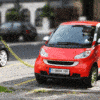2017 marked a record year for the electric vehicle industry, with over 4,000 new registrations per month. Considering only 3,500 electric vehicles were registered in the entire year of 2013, the electric vehicle market has witnessed significant growth over the past few years – with the popularity growth attributed to the developments in the industry that are slowly but surely overcoming the initial setbacks of electric vehicles.
Many drivers have allowed the initial setbacks in the industry to put them off purchasing an electric vehicle. However, the UK is working hard to provide more charging points across the country, whilst manufacturers are working to improve battery life and mileage range.
Nissan have recently launched their new Nissan Leaf with longer range and a one pedal driving system. The new Leaf is said to be able to travel around 50% further on one single charge than previous models. The Nissan Leaf is already branded as one of the most popular all-electric motors with over 283,000 sold since the model launched in 2010 – only coming behind the Mitsubishi Outlander PHEV. The new updates to the Leaf could push it up to the top spot, now it is able to travel further without needing to be charged.
The driving process as we know it could be completely transformed with Nissan’s new technology. Their one pedal driving system fitted in the new Leaf meant that at the press of a button the accelerator can be turned into an e-Pedal, and can function to start, accelerate, brake and stop the vehicle. Whilst drivers can still choose to operate their vehicle with a separate accelerator and brake, the system, if used, will also provide added energy efficiency gains.
Here, VW dealership, Vindis outline some of the latest developments in the industry that is driving it towards success.
The demand for more charging points
If global electric vehicle sales continue – which it is expected to, in line with the government’s plans to ban the sales of petrol and diesel cars by 2040 – then we will need to continue to build more charging points to fill the demand. By May 2017, there were more than 4,300 charging locations, with 6,700 charging devices and 12,500 connectors – but this won’t be enough in the future. And if we are to overcome the ongoing headache that is a full battery charging time of 8 hours, we will need an influx of rapid charging points which can charge up to 80% of an electric battery in just 30 minutes, as opposed to slower charge points. Thanks to a multimillion pound deal with ChargePoint back in May 2017, InstaVolt are installing at least 3,000 rapid charging points across fuel station forecourts across the UK.
However, our current infrastructure won’t be able to supply the electrical demand for the increase in charging points. According to the National Grid, peak demand for electricity could increase by 50%, if and when the nation switches to electric vehicles – which could be sooner than we think now that a new pan-European EV charging network has been announced too. IONITY, set up by the BMW Group, Daimler, Ford, and the VW Group with Audi and Porsche, launched the network early November 2017, and plans to work on 20 ultra-rapid charging points has already begun as they target for 400 points across Europe by 2020. 2018 is forecast to see the network expand across more than 100 locations with the intentions of making long distance EV travel easier.
The future of electric batteries
Currently, even the fastest charging batteries still take at least 30 minutes to charge – and that is at a rapid charging point. However, new research, as reported on by the Express, suggests a solution to this problem. Researchers claim they could have developed an ‘instantly rechargeable’ method that recharges an electric battery in the same time as it would take to fill a gas tank – a solution to the biggest headache of electric vehicles. This would revolutionise the EV industry, as battery life and its charge has been the biggest challenge for the industry. The new method is said to use fluid electrolytes to re-energise battery fluids – reducing the need for new infrastructure to support further recharging solutions.
We should expect to see more developments throughout the industry as the government continues to roll out their plans to hit the air quality targets. It is time for the industry to overcome some of their biggest headaches, and make EVs more appealing to drivers. If manufacturers can truly cut down the time it takes to recharge the battery, and develop batteries that can travel further, the industry could be revolutionised and experience an influx of drivers wanting to get their hands on an EV. Watch this space!













